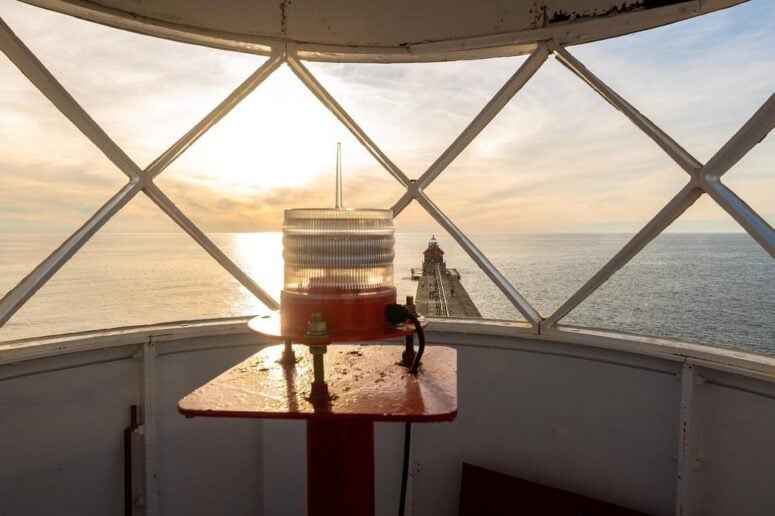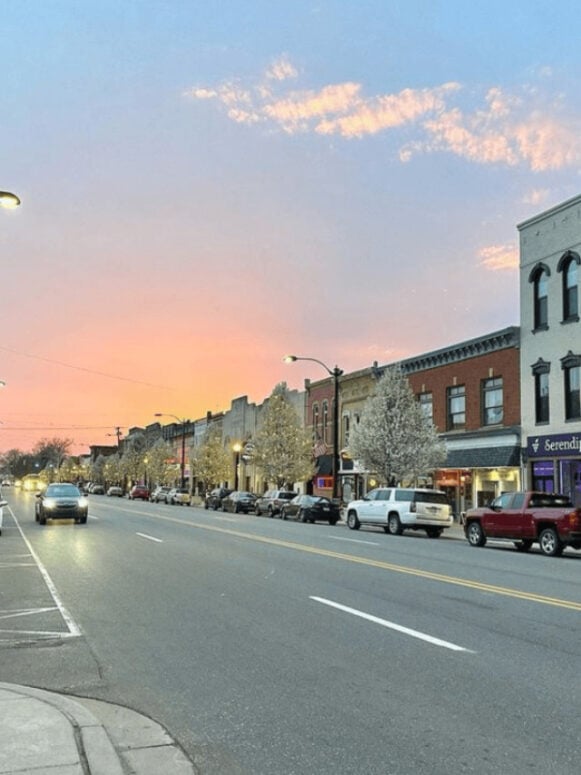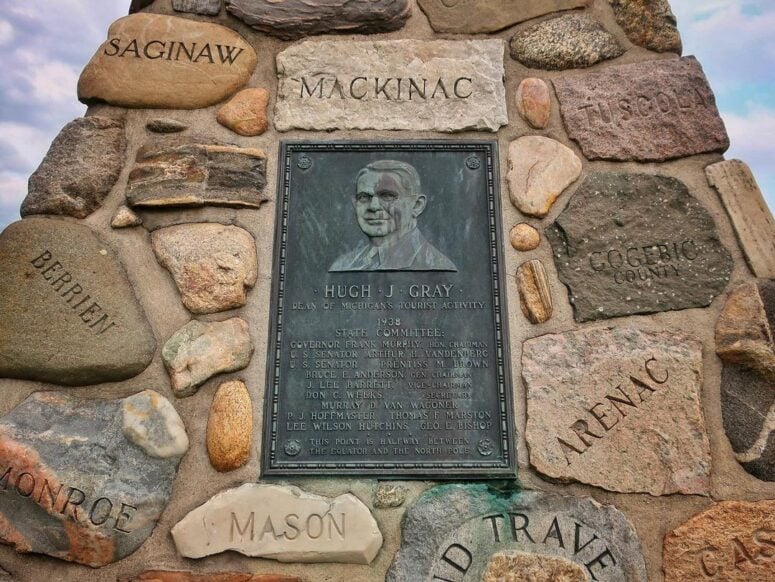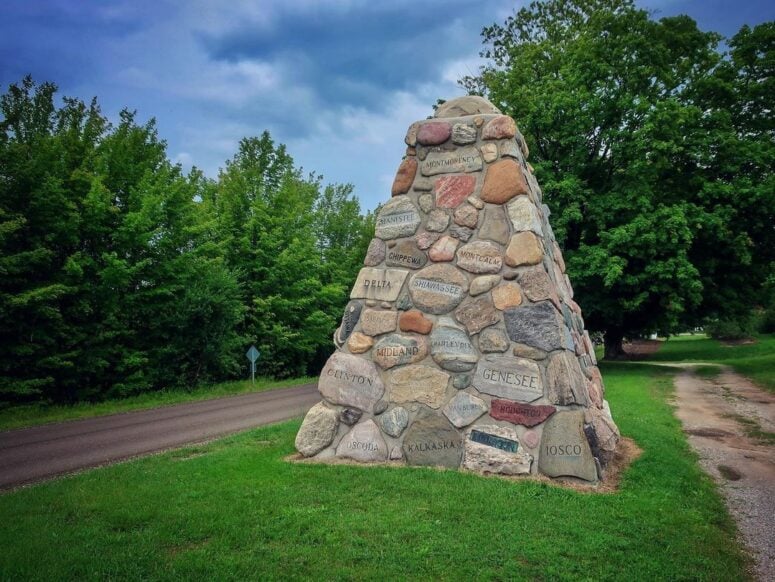What’s in a Name: Exploring the Origins of Michigan’s County Names
Would you like to save this full guide?
Behind each of Michigan’s 83 counties is a name that makes each county unique. Some are named for former governors of Michigan or national politicians. Some honor the state’s roots with names derived from Native American or French words or the state’s natural landmarks and the Great Lakes. Others honor Native American chiefs, missionaries, US generals, or Irish counties.
With 83 counties, Michigan ranks 15th in the nation in number of counties. No matter how counties in Michigan got their name, those names are a unique part of history and this guide provides a look at the origins of each Michigan county’s name.

Counties in Michigan’s Upper Peninsula
Gogebic County
The westernmost county in the Upper Peninsula was established in 1887 and gets its name from a lake with the same name, which was originally called Agogebic, an Ojibwe word that has been interpreted by different sources to mean body of water hanging on high, or water-mold lake. The county seat is in Bessemer.
Ontonagon County
Ontonagon County is named for the Ontonagon River, which comes from the Ojibwa word onagon, which means bowl or dish. The county was organized in 1848 and Ontonagon is the county seat.
Keweenaw County
The northernmost county in the Upper Peninsula, the “tip of the hat,” was formed in 1861. The name Keweenaw comes from the Ojibwe word gakiiwe-wewaning, which means portage; the practice of carrying cargo or watercraft around river obstacles or across two bodies of water. The county seat is in Eagle River and the county holds the distinction of being Michigan’s smallest county.
Houghton County
Just below Keweenaw County sits Houghton County, which has Houghton as its county seat. The county’s namesake is Douglass Houghton, a physician, a surgeon, a former mayor of Detroit, and Michigan’s first geologist. The county was established in 1845.
Iron County
Iron County is one of the only counties in Michigan not named for a person or from a Native American word. Its name comes from the iron mines and deposits found throughout the county. The county was established in 1885 and has Crystal Falls as its county seat.
Baraga County
Baraga County was formed in 1875 with L’Anse as its county seat. Like Houghton County, its name comes from a person; Frederic Baraga was a Catholic missionary and served as the first bishop of Sault Ste. Marie; the oldest city in Michigan.
Marquette County
The most populous county in the Upper Peninsula was established in 1843 and has Marquette as its county seat. It’s named for Jacques Marquette, a French Jesuit missionary who founded Sault Ste. Marie and St. Ignace.
Dickinson County
Dickinson County was established in 1891 and was named for Donald M. Dickinson. He grew up in Michigan, graduated from the University of Michigan law school in 1867, and was a very successful Detroit lawyer. He later served as Postmaster General for President Grover Cleveland. Iron Mountain is the county seat of Dickinson County.

Menominee County
Menominee County gets its name from the Menominee tribe; one of the historical tribes of the Upper Peninsula and Wisconsin. The tribe is remembered by the county name as well as the city of Menominee, which is the county seat. The county was established in 1861 and is the fourth most populous county in the UP.
Delta County
Delta County was established in 1843 and is named for the Greek letter Delta. The name referred to the original county’s triangular shape when it included parts of Marquette, Iron, Dickinson, and Menominee counties. Escanaba is the county seat here and its third most populous county in the UP.
Alger County
Alger County was established in 1885 and its borders include Pictured Rocks National Lakeshore. Munising serves as the seat for the county, which was named for Russell Alger, the 20th governor of Michigan.
Schoolcraft County
Manistique is the county seat of Schoolcraft County, which was established in 1843. Its namesake is Henry Rowe Schoolcraft, a geographer who had a hand in inventing the names of nine different counties in Michigan from a combination of Native American, Arabic, Latin, and Greek words.
Luce County
Luce County is the second smallest county in the UP and Michigan, but it’s well known as the home of Newberry, which is the county seat. The county was established in 1887 and is named for Henry Luce, a former governor of Michigan.
Chippewa County
Chippewa County is the easternmost county in the Upper Peninsula and is named for the Ojibwa tribe, who were also known as the Chippewa. The county was established in 1827 and Sault Ste. Marie, Michigan’s oldest settlement is the county seat.

Mackinac County
Mackinac County is the final county travelers pass through on the way to the Mackinac Bridge and the Lower Peninsula. Its name comes from the word michilimackinac, which is thought to be a French translation of big turtle, which is the name for Mackinac Island. It was established in 1818 and St. Ignace is the county seat.
Counties in Northern Michigan

Emmet County
The home of Petoskey was established in 1840 and is named for Robert Emmett. Emmett was an Irish Republican who established an independent Irish government in the late 1700s and early 1800s. He is also the namesake of Emmett, Michigan, and also a county in Iowa.
Cheboygan County
Cheboygan County was established in 1840 with Cheboygan as its county seat and is named for the Cheboygan River. The name itself is thought to come from the name Shabwegan, which was the name of a former Ojibwe settlement.
Presque Isle County
Established in 1840, Presque Isle County was named as a derivation of the French word for peninsula. Rogers City, known as the Salmon Capital of Michigan, is the county seat. With a population of just over 13,000 people, PI County as it’s known by residents, ranks toward the bottom of Michigan’s counties by population.
Charlevoix County
Scenic Charlevoix County on the shore of Lake Michigan has Charlevoix as its county seat and was established in 1869. Its name pays tribute to Pierre Francois Xavier de Charlevoix, a Jesuit traveler and a historian of New France, a former French territory that includes land that later became Michigan.
Antrim County
Antrim County was organized in 1863 and was known as Meegisee County from 1840-1843. Its name is taken from County Atrium, a county in Northern Ireland. Bellaire is the county seat and its population is just over 24,000.
Otsego County
Otsego County is perhaps best known for its county seat of Gaylord, a popular stop for travelers in Northern Michigan. The county was established in 1840 and is named for Otsego County, New York. The name Otsego is a Native American word meaning place of the rock.
Montmorency County
Montmorency cherries are famously grown in Michigan, but they can’t be found in this Northeast Michigan county. Atlanta, the Elk Capital of Michigan, is the county seat here and the county was established in 1840. Its name comes from the House of Montmorency, a distinguished noble family in France.
Alpena County
Alpena County was organized in 1857 and counts Alpena as its county seat. It was originally named Anamickee County by the Michigan legislature but was renamed in 1843 as Alpena by Henry Schoolcraft with a name meaning a good partridge county.
Leelanau County
The home of Michigan wine country was established in 1840. Suttons Bay Township is the county seat and the name is another creation of Henry Schoolcraft. The county’s name was traditionally said to mean delight of life, but Schoolcraft is said to have given it the name Leelinau as a way to describe Native American women. It was also said to be a penname of Schoolcraft’s wife Jane.
Grand Traverse County
Traverse City serves as the county seat of Grand Traverse County, which was organized in 1851. Its name comes from the French phrase grande traverse, which means long crossing, and was named by French voyageurs.

Benzie County
Nestled on the Lake Michigan shoreline, Benzie County was formed in 1863 and its county seat is Beulah. Its name is the French name of the Betsie River, which flows into Lake Michigan in Frankfort. The French name translates to river of sawbill ducks.
Kalkaska County
Formerly known as Wabassee County, Kalkaska County was later renamed by Henry Schoolcraft. The word is thought to be of Chippewa origin and means flat or burned-over country. Kalaska, the Trout Capital of Michigan, serves as its county seat.
Crawford County
Formed in 1840, Crawford County was known as Shawano County until 1843. It was, renamed for William Crawford, a land agent for George Washington during the Revolutionary War. It is one of four such named Crawford counties in the nation and Grayling is the county seat.
Oscoda County
Mio is the county seat of this small Lake Huron county. Henry Schoolcraft coined the name Oscoda, thought to be a combination of the Ojibwa words ossin and muskoda, for a name that means pebbly prairie.
Alcona County
Alphabetically, Alcona County is the first county in Michigan, which is even noted on its flag. Formerly known as Negwegon County, it was renamed in 1843 by Henry Schoolcraft, who combined parts of words from four different languages to form a word that means fine or excellent plain.
Manistee County
Manistee County’s name comes from the Manistee River. In turn, the word Manistee comes from an Ojibwe word ministigweyaa, which means river at whose mouth there are islands. The county was formed in 1840 and the county seat is Manistee.
Wexford County
Formed in 1840, Wexford County was formerly known as Kautawaubet County until 1843. It was subsequently renamed for County Wexford in Ireland. The county’s seat is Cadillac.
Missauke County
Missaukee County’s name honors Missaukee, a former leader of the Ottawa tribe, who signed different land-grant treaties. Lake City serves as the county seat.
Roscommon County
Four counties in Michigan are named for places in Ireland and Roscommon County is among that group. The county was formed in 1840 and Roscommon is the county seat.

Ogemaw County
More than a quarter of Michigan’s counties were either formed or had boundaries declared in 1840 and Ogemaw County is among that group. West Branch is the seat of Ogemaw County, which is named for the Ojibwe word ogimaa, which means chief.
Iosco County
The home of Tawas City was formed in 1840 and was named by Henry Schoolcraft. It was originally known as Kanotin County and the name Iosco was thought to mean water of light and was named by Schoolcraft.

Counties in West Michigan
Mason County
Located on the shore of Lake Michigan, Mason County was formed in 1840 and has Ludington as its county seat. It’s named for Stevens T. Mason, who served as the first governor of Michigan.
Lake County
Like Iron County in the Upper Peninsula, Lake County in Northern Michigan is named for its natural features; in this case the several small lakes within its borders and also its proximity to Lake Michigan. Baldwin is the county seat for Lake County, which was known as Aischum County from 1840-1843.
Osceola County
Formerly known as Unattin County from 1840-1843, Osceola County is named for the famous Seminole chief Osceola. Reed City is the county seat here.
Oceana County
The root of Oceana County’s name is simple: It borders Lake Michigan, which is considered to be a “freshwater ocean.” The county was formed in 1831 and Hart is the county seat.
Newaygo County
The name of Newaygo County is the center of some debate. One thought is that it’s name for an Ojibwe leader. Another thought is that it comes from an Algonquian word meaning much water. White Cloud is the county seat.
Mecosta County
Mecosta County, which has Big Rapids as its county seat, was formed in 1840. It’s named for Mecosta, a Potawatomi chief, who was born near what is today Big Rapids. Mecosta’s name in the Potawatomi language means having a bear’s foot.

Muskegon County
One of the biggest counties in West Michigan is named for the Muskegon River, which flows through the county. Muskegon, a name that comes from the Native American word mashkig, means marsh or swamp, is the county seat.
Ottawa County
The home of Grand Haven was formed in 1831 and is named for the Ottawa tribe. With more than 300,000 residents, it is among the 10 most populous counties in Michigan.
Kent County
Formed in 1831, Kent County has Grand Rapids as its county seat and is the fourth most populous county in the state. It’s named for James Kent, a jurist who represented the Michigan Territory during its dispute over the Toledo Strip with Ohio.
Montcalm County
This West Michigan county was formed in 1831 and has Stanton as its county seat. It’s named for Louis-Joseph de Montcalm, a French military commander who led forces in North America during the French and Indian War.
Ionia County
Ionia County was formed in 1831 and is named for an ancient Greek province. Ionia is its county seat.

Counties in Mid Michigan
Clare County
Formed in 1840, Clare County in mid-Michigan was formed from part of Mackinac County and unorganized territory. It was formerly known as Kaylakee County but was later renamed as a namesake for County Clare, Ireland. Harrison is the county seat.
Gladwin County
Gladwin County is named for Maj. Henry Gladwin, a British commander who is remembered for his defense of Fort Detroit during Pontiac’s Rebellion in 1763. Gladwin is the county seat and the county was formed in 1831.

Arenac County
Organized in 1883, Arenac County’s name is a creation of Henry Schoolcraft. The name is a combination of the Latin word arena and the Native American word ac; so all together the name means a sandy place for good footing. Standish is the county seat.
Isabella County
The home of Mt. Pleasant was formed in 1831 and is named for Queen Isabella of Spain. Isabella is best known as the monarch who gave Christopher Columbus patronage to undertake his voyages.
Midland County
Midland County was formed in 1831 and was named Midland because it’s located near the center of Michigan’s Lower Peninsula. Midland is the county seat.
Bay County
With Bay City as its county seat, Bay County was formed in 1857 from parts of three other counties. Its name comes from Saginaw Bay and Bay County is one of the 20 most populous counties in Michigan.

Gratiot County
Formed from unorganized territory in 1831, Gratiot County is named for Capt. Charles Gratiot, who built Fort Gratiot in Michigan’s thumbcoast and is also the namesake of Gratiot Avenue. Ithaca is the county seat.
Clinton County
Clinton County was formed in 1831 and named for DeWitt Clinton, a former New York governor, who is also the namesake of the Clinton River, Clinton Charter Township, and the city of DeWitt. St. Johns serves as the county seat.

Saginaw County
Saginaw County is the biggest county in the Great Lakes Bay region and has Saginaw as its county seat. Its name is believed to be a Native American term for at the outlet, which may refer to both Saginaw Bay and the Saginaw River.
Shiawassee County
Formed in 1822, Shiawassee County got its name from the Shiawasee River, which flows through six counties and means the river straight ahead from the Chippewa word shia-was-see. The county seat is Corunna.

Counties in East Michigan
Genesee County
Formed from parts of Lapeer County, Saginaw County, and Shiawassee County in 1835, Genesee County is known as the home of Flint, which serves as the county seat. Its name comes from the Seneca word je-nis-hi-yeh, which means beautiful valley, and is named for a valley in western New York.
Tuscola County
Tuscola County was formed from part of Sanilac County in 1840 and has Caro as its county seat. Its name is another creation of Henry Schoolcraft. The name translates to flat cultivated land and is derived from both Native American and Latin words.
Huron County
Formed in 1840, Huron County at the tip of Michigan’s thumb was named for Lake Huron, which was named for the Huron tribe. The county seat here is Bad Axe.

Sanilac County
While many Michigan county names come from Native American words, Sanilac County takes its name from Sanilac, who was a chief in the Wyandotte tribe. The county was formed in 1822 and Sandusky is its county seat.
Lapeer County
Formed in 1822 from parts of both Oakland and St. Clair counties, the name Lapeer is an Americanization of la pierre, which means the rock. Lapeer serves as the county seat.

Counties in South Central Michigan
Eaton County
Formed from unorganized territory in 1829, Eaton County has Charlotte as its county seat. Its name pays tribute to John Eaton, a former secretary of war under President Andrew Jackson; it is one of Michigan’s cabinet counties; 10 counties named for officials in Jackson’s administration.
Calhoun County
Calhoun County, formed in 1829, is another of Michigan’s cabinet counties; this one is named for famed Sen. John C. Calhoun, a former vice president under Andrew Jackson. Marshall is the county seat and the county also includes Battle Creek.
Branch County
Like the rest of Michigan’s cabinet counties, Branch County was formed in 1829 from unorganized territory. This county is named for Jackson’s Secretary of the Navy John Branch. The county’s seat is Coldwater.
Ingham County
Ingham County, which includes Michigan’s state capitol of Lansing within its borders, was declared in 1829 and organized in 1838. It’s named for Samuel Ingham, the secretary of the treasury in the Jackson administration; while Lansing is the biggest city in the county, Mason is the county seat.

Jackson County
Declared in 1829 and organized in 1832, Jackson County honors President Andrew Jackson, who led the United States when Michigan was admitted to the Union as the 26th state in 1837. It is Michigan’s 13th most populous county and Jackson is its county seat.
Hillsdale County
While many of the counties around Hillsdale County are named for political officials, Hillsdale gets its name from the surrounding area which is comprised of hills and dales. The county, one of the southernmost in Michigan, has Hillsdale as its county seat and was formed in 1829.

Counties in Southwest Michigan
Allegan County
The origins of Allegan County’s name are uncertain, but it’s possibly derived from the Native American word Allegawmi, an alternative name for Cherokee. What is known is that Henry Schoolcraft created the name to sound Native American. The county, whose biggest city is Holland, was organized in 1835 and has Allegan as its county seat.
Barry County
This cabinet county is named for Andrew Jackson’s Postmaster General William T. Barry. Established in 1829 and organized in 1839, Barry County’s county seat is Hastings, which is also the largest city in the county.
Van Buren County
While Martin Van Buren served as the eighth President of the United States, his service as Andrew Jackson’s secretary of state allowed him to be the namesake of this Southwest Michigan county. Formed in 1829, Paw Paw is the county seat of Van Buren County.
Berrien County
Another of the cabinet counties in Southwest Michigan, Berrien County is named for John Berrien, who served as Andrew Jackson’s attorney general. It ranks in the top quarter of Michigan’s most populous counties with a population of more than 150,000 and has St. Joe as its county seat.

Cass County
Cass County is named for Lewis Cass, who served as Secretary of War under Andrew Jackson. But Cass is perhaps better known as a former governor of Michigan, a Michigan senator, and the namesake of both Cass City and Cassopolis, Michigan, which is the county seat.
Kalamazoo County
Formed in 1829, Kalamazoo County has Kalamazoo as its county seat and an interesting name behind it. The county was named for the Kalamazoo River and Kalamazoo is a name that appears to derive from local native American tribes.
St. Joseph County
St. Joseph County was formed in 1829 and named for the St. Joseph River, which flows right through the county. The county seat is Centreville and the largest city in the county is Sturgis.
Counties in Southeast Michigan

Livingston County
Livingston County was organized in 1836 from parts of Shiawassee and Washtenaw County; Howell is its county seat. Its namesake is Edward Livingston, a former secretary of state under US President Andrew Jackson. Livingston is also the namesake of counties in Illinois and Missouri and a parish in Louisiana.
Washtenaw County
The home of Ann Arbor was organized in 1826. The sixth most populous county in Michigan gets its name from the Native American name for the Grand River O-wash-ta-nong, a name which means faraway water.
Oakland County
Michigan’s second-most populous county is part of Metro Detroit’s tri-county area along with Macomb and Wayne counties. It was organized in 1820 and Pontiac is its county seat. Its name comes from the numerous orchards and oak trees in the area.
Macomb County
Michigan’s third most populous county was established in 1818 and has Mt. Clemens as its county seat. Its name honors Gen. Alexander Macomb, a career military officer who was born in Detroit, served during the War of 1812, and was the Commanding General of the US Army for more than a decade.

St. Clair County
Nestled in Michigan’s thumb, St. Clair County was established in 1820 and has Port Huron as its county seat. The county has two possible name origins. One is the namesake of Arthur St. Clair, the first governor of the Northwest Territory; the other is for St. Clair, an Italian saint with a feast day, on which Lake St. Clair was discovered.
Wayne County
Michigan’s most populous county, which includes Detroit as its county seat, was established in 1815 and is home to more than 1.7 million people. The county is named for famed US general “Mad” Anthony Wayne, who is also the namesake of Wayne State University.
Lenawee County
Lenawee County’s name comes from a Schoolcraft pseudo-Native American name meaning man from either the Shawnee word lenawai or the Delaware word lenno. The county has Adrian as its county seat and was established in 1822.
Monroe County
Established in 1817, Monroe County is one of Michigan’s oldest counties and one of its 15 biggest. The county was named for James Monroe, the fifth US President, who is the namesake of 17 different Monroe counties in the United States. Monroe is also the county seat of Monroe County, Michigan.

Discover the Michigan County Cairn in Kewadin
Located slightly north of Kewadin, Michigan, an extraordinary monument dedicated to the 45th Parallel can be found in a quaint roadside park along a rural route.
Constructed in 1938, this monument is a cairn, a unique structure composed of rocks collected from all 83 counties in Michigan. Each rock is marked to indicate its county of origin, allowing visitors to identify and appreciate the diverse geological contributions from across the state.
This monument serves as a homage to Hugh J. Gray, a pioneer in promoting state tourism and the inaugural director of the Western Michigan Tourist & Resort Association. Gray played a pivotal role in revitalizing the region’s economy through tourism, following the decline of the lumber industry.
In recognition of his over two decades of dedication, a cairn was erected in his honor, celebrated with a lavish banquet in Traverse City on June 28, 1938. The event was attended by notable figures, including Governor Frank Murphy and U.S. Senators Arthur H. Vandenburg and Prentiss M. Brown.

Fun Fact: Hidden behind the monument’s plaque is a time capsule containing historical newspapers and tourist brochures, capturing the essence of the era.
The cairn’s location, while seemingly arbitrary, is actually a few miles south of the true 45th Parallel, which is precisely marked further north along the highway. This discrepancy adds to the monument’s mystique, inviting speculation about its placement and the symbolic significance of the stones.
Originally, US Highway 31 ran adjacent to the monument, making it a prominent landmark. However, the highway was later rerouted, leading to the monument and the Old Cairn Highway being overlooked by many travelers. Despite this, the area still holds historical significance, evidenced by the remnants of the “Polar Equator Trail,” a tourism initiative from the early 1970s aimed at highlighting Michigan’s natural beauty along the 45th Parallel.

The monument not only commemorates Hugh Gray’s contributions to Michigan tourism but also stands as a testament to the state’s collective effort to honor its heritage. The varied stones, including an unconventional rubber cube from Wexford County, symbolize the unity and diversity of Michigan’s communities.
As US Highway 31 and the Old Cairn Highway converge north of the monument, visitors are reminded of the geographical and historical significance of the 45th Parallel, marking the midpoint between the Equator and the North Pole.

Visit One of Michigan’s 83 Counties Today
No matter where you travel, each of Michigan’s 83 counties is waiting to be discovered. Every county, no matter how big or how small is brimming with history, famous landmarks, unique roadside attractions, quaint eateries, and plenty more to satisfy every type of traveler.
Whether you travel a few counties over from your home base or you’re visiting from out of town, Michigan’s counties are perfect for exploring on a quick day trip or a long state road trip. So whether you want to travel from Wayne County to Saginaw County or make the journey from Schoolcraft County to Gogebic County, now is the perfect time to plan your next Michigan adventure!

